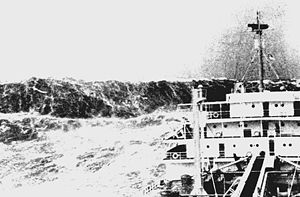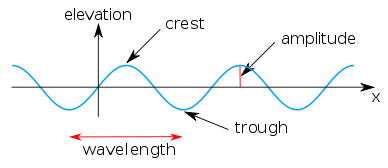
Wave height
Encyclopedia

Fluid dynamics
In physics, fluid dynamics is a sub-discipline of fluid mechanics that deals with fluid flow—the natural science of fluids in motion. It has several subdisciplines itself, including aerodynamics and hydrodynamics...
, the wave height of a surface wave
Ocean surface wave
In fluid dynamics, wind waves or, more precisely, wind-generated waves are surface waves that occur on the free surface of oceans, seas, lakes, rivers, and canals or even on small puddles and ponds. They usually result from the wind blowing over a vast enough stretch of fluid surface. Waves in the...
is the difference between the elevation
Elevation
The elevation of a geographic location is its height above a fixed reference point, most commonly a reference geoid, a mathematical model of the Earth's sea level as an equipotential gravitational surface ....
s of a crest
Crest (physics)
A crest is the point on a wave with the maximum value or upward displacement within a cycle. A trough is the opposite of a crest, so the minimum or lowest point in a cycle.-Interference:...
and a neighbouring trough. Wave height is a term used by mariners, as well as in coastal, ocean
Ocean engineering
Ocean engineering is an ambiguously defined term that may refer to:*Oceanographic engineering, also called marine electronics engineering, concerned with the design of electronic devices for use in the marine environment, such as the remote sensing systems used by oceanographers*Offshore...
and naval engineering.
At sea, the term significant wave height
Significant wave height
In physical oceanography, the significant wave height is defined traditionally as the mean wave height of the highest third of the waves , but now usually defined as four times the standard deviation of the surface elevation...
is used as a means to introduce a well-defined and standardized statistic
Statistic
A statistic is a single measure of some attribute of a sample . It is calculated by applying a function to the values of the items comprising the sample which are known together as a set of data.More formally, statistical theory defines a statistic as a function of a sample where the function...
to denote the characteristic height of the random waves in a sea state
Sea state
In oceanography, a sea state is the general condition of the free surface on a large body of water—with respect to wind waves and swell—at a certain location and moment. A sea state is characterized by statistics, including the wave height, period, and power spectrum. The sea state varies with...
. It is defined in such a way that it more–or–less corresponds to what a mariner observes when estimating visually the average wave height.
Several definitions for different situations

- For a sine waveSine waveThe sine wave or sinusoid is a mathematical function that describes a smooth repetitive oscillation. It occurs often in pure mathematics, as well as physics, signal processing, electrical engineering and many other fields...
, the wave height H is twice the amplitudeAmplitudeAmplitude is the magnitude of change in the oscillating variable with each oscillation within an oscillating system. For example, sound waves in air are oscillations in atmospheric pressure and their amplitudes are proportional to the change in pressure during one oscillation...
:
- For a periodic wavePeriodic functionIn mathematics, a periodic function is a function that repeats its values in regular intervals or periods. The most important examples are the trigonometric functions, which repeat over intervals of length 2π radians. Periodic functions are used throughout science to describe oscillations,...
it is simply the difference between the maximum and minimum of the surface elevation z = η(x – cp t):
- with cp the phase speed (or propagation speed) of the wave. The sine wave is a specific case of a periodic wave.
- In random waves at sea, when the surface elevations are measured with a wave buoyWeather buoyWeather buoys are instruments which collect weather and ocean data within the world's oceans, as well as aiding during emergency response to chemical spills, legal proceedings, and engineering design. Moored buoys have been in used since 1951, while drifting buoys have been used since 1979...
, the individual wave height Hm of each individual wave—with an integerIntegerThe integers are formed by the natural numbers together with the negatives of the non-zero natural numbers .They are known as Positive and Negative Integers respectively...
label m, running from 1 to N, to denote its position in a sequence of N waves—is the difference in elevation between a wave crest and trough in that wave. For this to be possible, it is necessary to first split the measured time seriesTime seriesIn statistics, signal processing, econometrics and mathematical finance, a time series is a sequence of data points, measured typically at successive times spaced at uniform time intervals. Examples of time series are the daily closing value of the Dow Jones index or the annual flow volume of the...
of the surface elevation into individual waves. Commonly, an individual wave is denoted as the time interval between two successive downward-crossings through the averageAverageIn mathematics, an average, or central tendency of a data set is a measure of the "middle" value of the data set. Average is one form of central tendency. Not all central tendencies should be considered definitions of average....
surface elevation (upward crossings might also be used). Then the individual wave height of each wave is again the difference between maximum and minimum elevation in the time interval of the wave under consideration.
- Significant wave heightSignificant wave heightIn physical oceanography, the significant wave height is defined traditionally as the mean wave height of the highest third of the waves , but now usually defined as four times the standard deviation of the surface elevation...
H1/3, or Hs or Hsig, in the time domainTime domainTime domain is a term used to describe the analysis of mathematical functions, physical signals or time series of economic or environmental data, with respect to time. In the time domain, the signal or function's value is known for all real numbers, for the case of continuous time, or at various...
, is defined as the average height of the one-third part of the measured waves—which are N in number—having the largest wave heights:
- with Hm the individual wave heights, sorted in such a way that the highest wave has m=1 and the lowest wave is for m=N. Only the highest one-third is used, since this corresponds best with visual observations of experienced mariners: eyes and brain apparently focus on the higher waves seen.
- Significant wave height Hm0, defined in the frequency domainFrequency domainIn electronics, control systems engineering, and statistics, frequency domain is a term used to describe the domain for analysis of mathematical functions or signals with respect to frequency, rather than time....
, is used both for measured and forecastForecastingForecasting is the process of making statements about events whose actual outcomes have not yet been observed. A commonplace example might be estimation for some variable of interest at some specified future date. Prediction is a similar, but more general term...
ed wave variance spectra. Most easily, it is defined in terms of the varianceVarianceIn probability theory and statistics, the variance is a measure of how far a set of numbers is spread out. It is one of several descriptors of a probability distribution, describing how far the numbers lie from the mean . In particular, the variance is one of the moments of a distribution...
m0 or standard deviationStandard deviationStandard deviation is a widely used measure of variability or diversity used in statistics and probability theory. It shows how much variation or "dispersion" there is from the average...
ση of the surface elevation:
- where m0, the zeroth-momentMoment (mathematics)In mathematics, a moment is, loosely speaking, a quantitative measure of the shape of a set of points. The "second moment", for example, is widely used and measures the "width" of a set of points in one dimension or in higher dimensions measures the shape of a cloud of points as it could be fit by...
of the variance spectrum, is obtained by integration of the variance spectrum. In case of a measurement, the standard deviation ση is the easiest and most accurate statistic to be used.
- Another wave-height statistic in common usage is the root-mean-square wave height (or RMS wave height) Hrms, defined as:
- with Hm again denoting the individual wave heights in a certain time seriesTime seriesIn statistics, signal processing, econometrics and mathematical finance, a time series is a sequence of data points, measured typically at successive times spaced at uniform time intervals. Examples of time series are the daily closing value of the Dow Jones index or the annual flow volume of the...
.






